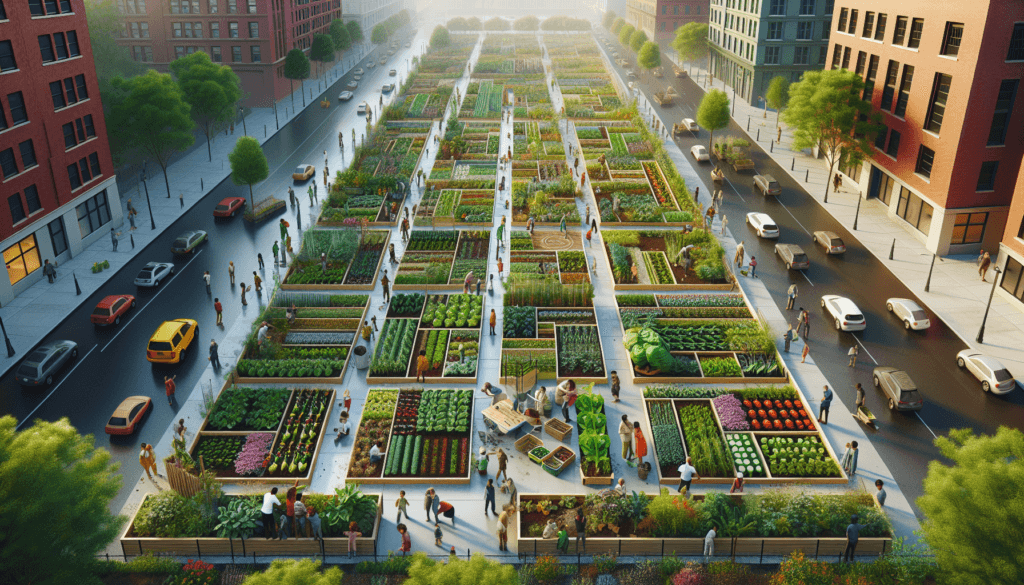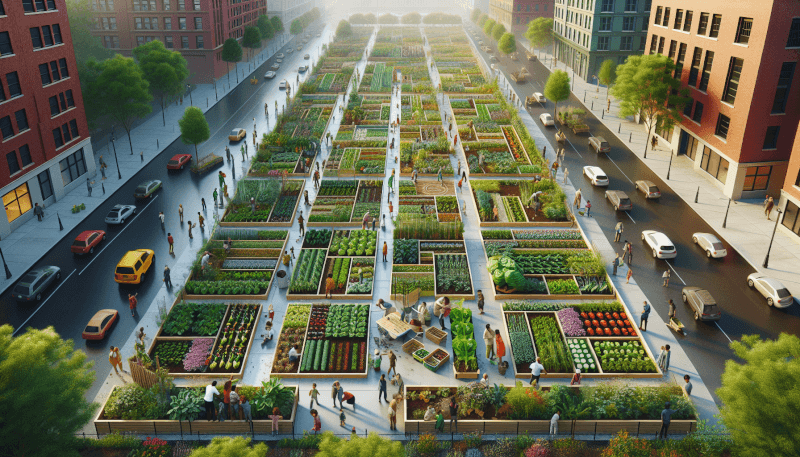Are you interested in starting a community garden in your urban area? Look no further! This article will provide you with valuable tips and resources to help you begin your own green oasis. Whether you have a small plot of land or are looking to transform a vacant lot, we’ve got you covered. From selecting the right plants to organizing volunteers, you’ll find all the information you need to kick-start your community garden project. Get ready to connect with nature, bond with your neighbors, and transform your urban landscape into a thriving garden haven.

Benefits of Community Gardens
Community gardens have numerous benefits that positively impact individuals and neighborhoods. By establishing and maintaining a community garden, you can contribute to improving food security and access to fresh produce in your area. These gardens provide an opportunity for individuals and families to grow their own nutritious fruits and vegetables, reducing their dependence on grocery stores and increasing their control over what they eat. Additionally, community gardens often share excess produce with participants, further enhancing food security within the community.
One of the key advantages of community gardens is their ability to promote community engagement and social connections. Gardening brings people together, allowing them to share knowledge, resources, and experiences. It serves as a gathering place where neighbors can meet, interact, and forge new friendships. The shared goal of nurturing plants and creating a beautiful space fosters a sense of belonging and unity among participants, resulting in a stronger and more connected community.
Community gardens also play a vital role in enhancing both physical and mental well-being. Engaging in gardening activities provides a form of exercise that is enjoyable and fulfilling. From planting seeds to harvesting crops, every step of the process requires physical movement and exertion. This physical activity can help improve cardiovascular health, increase strength and flexibility, and contribute to overall wellness. In addition, the exposure to nature and fresh air while gardening has been shown to reduce stress levels and improve mental health, offering a natural and therapeutic remedy for the pressures of daily life.
Furthermore, community gardens offer valuable opportunities for education and skill-building. They provide a platform for individuals of all ages to learn about gardening techniques, environmental stewardship, and sustainable practices. Many community gardens also organize workshops and classes on topics such as composting, seed saving, and organic pest control. These educational activities empower community members to develop new skills and knowledge, fostering a culture of self-sufficiency and environmental consciousness.
Choosing a Suitable Location
Choosing the right location for your community garden is crucial for its long-term success. Start by identifying available spaces within your community that can accommodate a garden. These spaces can include vacant lots, unused schoolyards, or even underutilized sections of parks. Consider reaching out to local government agencies, community organizations, or property owners to explore potential locations.
Once you have identified potential spaces, assess the soil quality and sunlight exposure of each area. A successful garden requires soil that is fertile and well-drained. Consider conducting soil tests to determine nutrient levels and pH balance. Additionally, observe the amount of sunlight each area receives throughout the day. Most vegetables and fruits require at least six hours of direct sunlight daily to thrive.
Accessibility is another important factor to consider when choosing a location. Ensure that the garden is easily accessible for community members, including those with disabilities, by considering factors such as proximity to public transportation, parking availability, and the presence of ramps or other accessibility features.
Finally, it is crucial to obtain the necessary permits and permissions before establishing a community garden. Check with local authorities or property owners to understand the legal requirements and zoning regulations that may apply. This process may involve obtaining permits, liability insurance, and written agreements with property owners. By addressing these factors from the outset, you can ensure a smooth and sustainable development process for your community garden.

Forming a Community Garden Committee
To ensure the smooth operation and sustainability of a community garden, it is crucial to form a dedicated committee responsible for overseeing its management. Start by recruiting enthusiastic and committed individuals from the community who share a passion for gardening and community engagement. Look for a diverse mix of skills and expertise, such as gardening knowledge, organizational skills, and volunteer management experience.
Once the committee is formed, assign key roles and responsibilities to each member. These roles may include a chairperson or coordinator who oversees the overall operations, a treasurer responsible for managing finances and fundraising, and a secretary who handles communication and record-keeping. Clearly defining roles and distributing responsibilities ensures that every aspect of the garden’s management is accounted for and promotes efficiency and accountability.
Establish clear communication channels within the committee and with the broader community. Regular meetings, email updates, and online platforms can help facilitate efficient and transparent communication. By fostering open lines of communication, committee members can stay informed about garden-related activities, make important decisions together, and involve the community in the decision-making process.
Creating a shared vision and goals is also essential for the success of a community garden. Engage the committee and community members in a collaborative process to define the purpose, values, and objectives of the garden. This shared vision will serve as a guiding framework for decision-making, outreach efforts, and future development. Regularly revisit and revise the vision and goals to ensure they remain aligned with the evolving needs and aspirations of the community.
Building a Supportive Community
Creating a supportive community is a fundamental aspect of a successful community garden. Engage with local residents and organizations to garner support and involvement. Attend neighborhood association meetings, reach out to schools and churches, and connect with other community groups to spread the word about the garden and invite their participation.
Building partnerships with schools and businesses can be a mutually beneficial endeavor. Schools can incorporate the community garden into their curriculum, allowing students to learn about gardening and environmental education. Businesses can provide resources, volunteers, or even sponsorships to support the garden. These partnerships not only provide valuable contributions but also strengthen community ties and create a sense of shared ownership.
Involving community leaders and policymakers is another important step in building a supportive community. Engage with elected officials, local organizations, and influential community members to advocate for the garden’s importance and potential impact. Showing the value of the garden in terms of food security, community health, and environmental sustainability can help garner support and promote its long-term success.
Facilitate inclusive membership and participation in the community garden. Ensure that barriers to participation, such as language barriers or financial constraints, are addressed. Offer translated materials, provide gardening tools and equipment for communal use, and explore potential funding sources to support individuals who may not have the resources to participate fully. By actively working towards inclusivity, you can ensure that the garden is accessible and welcoming to individuals of all backgrounds and abilities.

Gathering Essential Resources
Creating a community garden requires gathering essential resources to support its operation and development. Securing funding and grants is often a critical step in this process. Research and apply for grants specifically designed to support community gardens, or explore local funding opportunities through community foundations, government agencies, or corporate sponsorships. Additionally, consider crowdfunding platforms or organizing fundraising events to engage the community and gather financial resources.
Sourcing garden tools and equipment is essential for the successful maintenance and operation of the garden. Many community gardens operate on a shared model, where tools are collectively owned and maintained. Seek out donations or borrow equipment from community members, businesses, or local gardening groups. Hosting tool drives or organizing tool swap events can also be a great way to gather the necessary resources.
Finding materials for raised beds and composting is crucial for creating a sustainable and productive garden. Explore local resources such as farms, construction sites, or landscaping businesses that may have excess materials such as wood, compost, or mulch. Additionally, consider organizing community composting initiatives to collect organic waste from the community and turn it into nutrient-rich compost for the garden.
Accessing resources for irrigation and water management is also essential, especially in areas with limited access to water. Research alternative watering methods such as rainwater harvesting, drip irrigation systems, or greywater systems. Local water agencies or environmental organizations may offer resources, rebates, or training related to water conservation practices. By maximizing water efficiency and reducing waste, you can create a sustainable garden and minimize the impact on local water resources.
Planning and Designing the Garden
The planning and design phase of a community garden sets the foundation for its overall layout and functionality. Start by creating a garden layout and design that optimizes space, maximizes efficiency, and supports diverse planting options. Consider the needs and preferences of the community, such as communal gathering spaces, pathways for easy access, and areas designated for educational or recreational activities.
Incorporating sustainable and organic gardening practices is also essential. Avoid the use of synthetic fertilizers, pesticides, and herbicides, instead opting for natural alternatives that promote soil health and minimize harm to the environment. Implementing composting systems, using companion planting techniques, and encouraging biodiversity can enhance the garden’s resilience and long-term sustainability.
Design pathways, seating areas, and gathering spaces within the garden to create an inviting and functional space for community members. Clearly marked pathways allow for easy access and navigation, while strategically placed benches or seating areas provide opportunities for rest and reflection. Consider incorporating community art or signage that showcases the garden’s purpose and embraces the cultural diversity of the community.
To ensure the garden is accessible to all community members, incorporate accessible features throughout the design. This includes providing wide pathways for wheelchair access, raised beds or containers at varying heights, and sensory garden elements designed for individuals with visual impairments. By considering the needs of all community members, you can create an inclusive and welcoming environment that fosters equal participation.

Preparing the Soil and Planting
Preparing the soil is a vital step in creating the optimal growing conditions for plants in the community garden. Test the soil to assess its nutrient levels, pH balance, and overall quality. Based on the test results, amend the soil by adding organic matter, such as compost or aged manure, to improve its fertility and structure. Adequate soil preparation sets the stage for healthy plant growth and an abundant harvest.
Choosing appropriate plants and seeds is crucial for a successful community garden. Consider the climate, available sunlight, and space constraints when selecting plants. Opt for crops that are well-suited to your region and require minimal maintenance. In addition to food crops, consider incorporating flowers, herbs, or native plants to support pollinators and enhance the overall beauty and biodiversity of the garden.
Prepare raised beds and containers for planting. Construct raised beds using untreated wood or other durable materials to create defined growing areas. Fill the beds with a well-balanced soil mix that provides good drainage and nutrient retention. Containers can be used to grow plants in limited spaces or paved areas. Ensure containers have adequate drainage holes and use quality potting soil.
Implement proper planting and spacing techniques to optimize plant growth and productivity. Follow recommended planting depths, spacing guidelines, and watering requirements for each plant. This ensures that plants have sufficient room to grow and access necessary resources. Regularly monitor the garden, water plants as needed, and provide support or trellises for climbing plants.
Maintaining and Managing the Garden
Establishing a maintenance schedule and tasks is essential for the ongoing care and management of the community garden. Create a calendar outlining regular maintenance activities such as watering, weeding, and pest control. Assign specific tasks to committee members or volunteers and ensure that everyone understands their responsibilities. Regularly communicate and update the schedule to accommodate changing needs and growing seasons.
Watering, weeding, and pest control are key components of garden maintenance. Develop an irrigation system that meets the needs of the plants while using water efficiently. Regularly monitor soil moisture levels and adjust watering accordingly. Implement organic pest control methods such as companion planting, physical barriers, or natural insect repellents to minimize the use of harmful chemicals.
Promoting sustainable gardening practices is essential in maintaining the health of the garden and minimizing its environmental impact. Encourage composting of organic waste within the garden and use the resulting compost to nourish the soil. Practice proper waste management by recycling or reusing materials whenever possible. By modeling sustainable practices, you can inspire and educate community members about the importance of environmental stewardship.
Facilitate ongoing education and training by organizing workshops, classes, and demonstrations within the garden. These events can cover a wide range of topics including gardening techniques, soil health, pest management, and nutrition. Involve local experts or master gardeners to lead these educational sessions, providing valuable knowledge and skills to the community. Ongoing education empowers community members to become self-sufficient gardeners and ensures the garden remains a vibrant and thriving space.

Engaging the Community
Engagement is key to fostering a dynamic and vibrant community garden. Organize garden workdays and events regularly to bring community members together and accomplish necessary tasks. These workdays provide an opportunity for individuals to contribute their time and effort towards the maintenance and improvement of the garden. By working side by side, community members can forge strong connections and build a sense of ownership and pride in the garden.
Hosting educational workshops and classes within the garden is an effective way to engage the community and share knowledge. Organize sessions focused on gardening techniques, cooking demonstrations, or nutrition education. Encourage community members to share their skills and expertise by leading workshops or participating as guest speakers. These educational opportunities not only empower individuals but also strengthen the bonds within the community.
Facilitate community celebrations and gatherings within the garden to promote social connections and meaningful interactions. Organize seasonal festivals, potluck dinners, or harvest celebrations that bring community members together to enjoy the bounty of the garden. Create a welcoming and festive atmosphere, incorporating music, art, and cultural elements to reflect the diverse backgrounds of the community. These gatherings serve as joyful occasions for community members to connect, strengthen relationships, and celebrate the collective efforts of the garden.
Encouraging active involvement and collaboration is essential for the long-term sustainability and growth of the community garden. Regularly seek input and feedback from community members to understand their needs and aspirations. Involve participants in decision-making processes, such as selecting crops for the upcoming season or planning garden improvements. By fostering a sense of belonging and shared responsibility, you can create a garden that truly reflects the desires and strengths of the community.
Evaluating and Celebrating Success
Evaluation and celebration are important components of maintaining and improving a community garden. Collect feedback from community members and assess the outcomes and impact of the garden. This can be done through surveys, informal conversations, or organized focus groups. Analyze the data collected to identify areas of improvement and ensure the garden continues to meet the needs and expectations of the community.
Measure the impact of the community garden on food security and the well-being of community members. Track the quantity of produce harvested and shared within the community. Monitor changes in participants’ dietary habits or knowledge about gardening and nutrition. Assess the community’s sense of food security and individual well-being as a result of their involvement in the garden. This data will provide valuable insights that can be used to advocate for support and resources for the garden.
Recognize and appreciate the contributions of volunteers and community members who have dedicated their time and effort to the garden. Host appreciation events, share success stories, and publicly acknowledge the achievements of individuals and the community as a whole. Celebrating the garden’s successes not only boosts morale and motivation but also attracts new participants and fosters a sense of pride and ownership.
Share success stories and lessons learned with other community gardens and organizations. By documenting the challenges faced, strategies implemented, and achievements attained, you can inspire and guide others who wish to establish their own community gardens. Share your experiences through local publications, social media platforms, or by hosting garden tours and workshops. By sharing knowledge and resources, you can contribute to the growth and success of the broader community garden movement.


